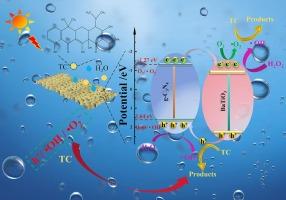g-C3N4/BaTiO3/PVDF membrane photocatalytic degradation of tetracycline
IF 5.9
3区 工程技术
Q1 CHEMISTRY, MULTIDISCIPLINARY
Journal of Industrial and Engineering Chemistry
Pub Date : 2025-05-14
DOI:10.1016/j.jiec.2025.05.015
引用次数: 0
Abstract
Environmental pollution poses a major hurdle to sustainable development, and harnessing solar energy for water treatment has emerged as a promising solution. In this study, flexible, macroporous photocatalytic membranes were developed by combining photocatalysis with membrane separation technology and hydrogen peroxide (H2O2), aiming to improve the degradation efficiency of tetracycline (TC). The g-C3N4/BaTiO3/PVDF photocatalytic membranes were fabricated using a phase inversion method, which successfully addressed challenges such as catalyst agglomeration and recovery difficulties, surpassing traditional membrane separation methods. Additionally, the g-C3N4/BaTiO3 photocatalyst exhibited excellent compatibility with PVDF. Under 120 min of xenon lamp irradiation, the membranes achieved a TC degradation efficiency of 90.63 %. These membranes also demonstrated remarkable permeability, and they maintained high stability and reusability after five degradation cycles, showcasing their promising potential for photocatalytic water treatment applications.

g-C3N4/BaTiO3/PVDF膜光催化降解四环素
环境污染是可持续发展的主要障碍,利用太阳能进行水处理已成为一种有希望的解决方案。本研究将光催化与膜分离技术和过氧化氢(H2O2)相结合,开发了柔性的大孔光催化膜,以提高四环素(TC)的降解效率。采用相转化法制备了g-C3N4/BaTiO3/PVDF光催化膜,成功解决了催化剂团聚和回收困难等难题,超越了传统的膜分离方法。此外,g-C3N4/BaTiO3光催化剂与PVDF具有良好的相容性。在氙灯照射120 min时,膜对TC的降解效率为90.63%。这些膜还表现出卓越的渗透性,并且在五次降解循环后仍保持高稳定性和可重复使用性,显示出它们在光催化水处理应用中的巨大潜力。
本文章由计算机程序翻译,如有差异,请以英文原文为准。
求助全文
约1分钟内获得全文
求助全文
来源期刊
CiteScore
10.40
自引率
6.60%
发文量
639
审稿时长
29 days
期刊介绍:
Journal of Industrial and Engineering Chemistry is published monthly in English by the Korean Society of Industrial and Engineering Chemistry. JIEC brings together multidisciplinary interests in one journal and is to disseminate information on all aspects of research and development in industrial and engineering chemistry. Contributions in the form of research articles, short communications, notes and reviews are considered for publication. The editors welcome original contributions that have not been and are not to be published elsewhere. Instruction to authors and a manuscript submissions form are printed at the end of each issue. Bulk reprints of individual articles can be ordered. This publication is partially supported by Korea Research Foundation and the Korean Federation of Science and Technology Societies.

 求助内容:
求助内容: 应助结果提醒方式:
应助结果提醒方式:


